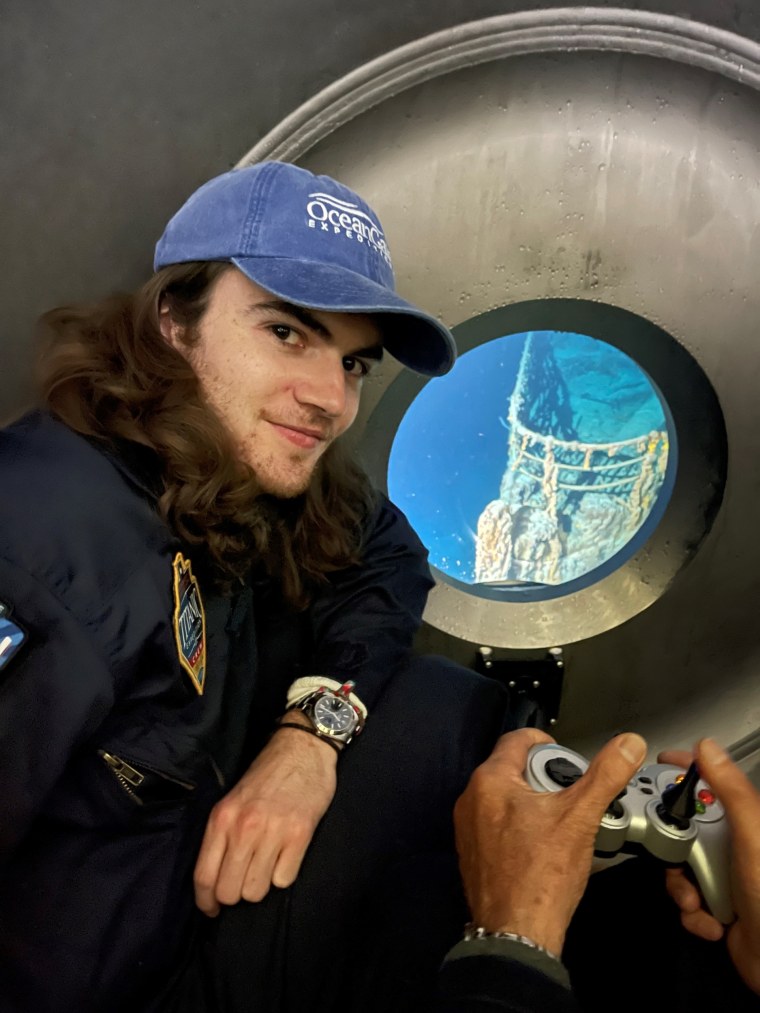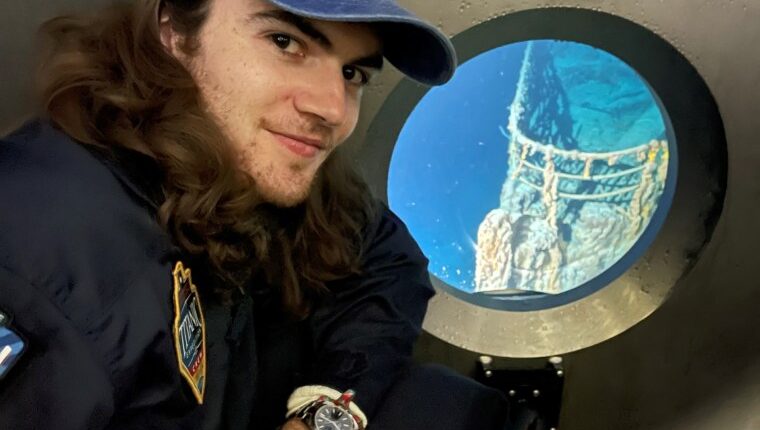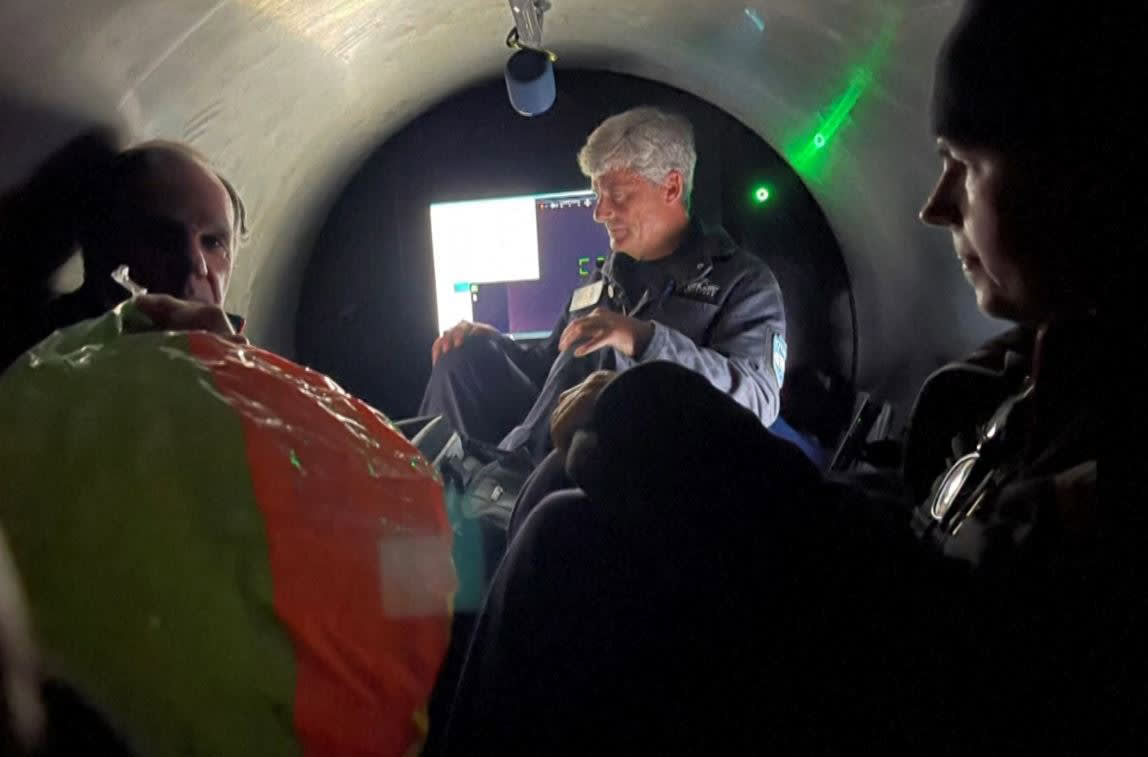The Titan was touted as a groundbreaking submersible that could give tourists the extraordinary chance to visit the deep-sea grave of the Titanic — but past passengers have since shared chilling accounts of safety issues, communication failures and design concerns.
The desperate search for the missing submersible and the five passengers on board entered its fourth day Thursday, after the Titan lost contact with its mother ship during the Sunday dive to the Titanic, 12,500 feet below the surface of the ocean.
Equipped with an estimated 96 hours worth of oxygen at departure, the vessel may now be out of breathable air. The 21-foot, carbon fiber and titanium submersible fits five people, with no seats and a curtained off area for a makeshift bathroom.
Malfunctions left passengers like ‘sitting ducks’
Brian Weed, a 42-year-old camera operator for Discovery Channel’s “Expedition Unknown,” did a test dive on the Titan in May 2021, and said, “the moment we started the test dive, things started going wrong.”
They descended in the submersible, but not all the way to the shipwreck.
The launch was “clumsy,” and less than a quarter of the dive in, “there were malfunctions with the propulsion system,” leaving them like “sitting ducks in the water,” Weed recalled.
“This was supposedly two months before they were supposed to take their first dive down to the Titanic and that was very worrying for me. We were supposed to be on one of those first dives,” he said.
He was also concerned by the fact that the door to the Titan was bolted from the outside, saying, “there’s still a potential that there’s no way out even if you’re on the surface.”
But it was the allure of the Titanic — the ocean liner that sank on its maiden voyage from England to New York in 1912 — that drew him to the project.
“The thought of going down and seeing the Titanic really clouds your mind. You want this to be possible. You want this to be true. Your brain is willing to overlook some really glaring problems,” he said.
“The thought of going down and seeing the Titanic really clouds your mind. You want this to be possible. You want this to be true. Your brain is willing to overlook some really glaring problems.”
Said Brian Weed
Weed declined an invitation to dive again one week later.
No stranger to risky situations, Weed said, “something about this felt like there wasn’t a plan” and “the reward is not worth the risk.”
Josh Gates, the host of “Expedition Unknown,” told NBC News’ Tom Costello on that dive: “We had issues with thruster control. We had issues with the computers aboard, we had issues with comms.”
“I just felt as though the sub needed more time, and it needed more testing, frankly,” he said.
OceanGate completed successful expeditions to the wreckage in 2021 and 2022, before going missing on the third trip.
Lost communications, wandering for hours underwater
Colin Taylor, who went on the submersible when it explored the Titanic site in July 2022 with his 22-year-old son, described the communication system as “very difficult.”

“There’s a text based communication system that’s two-way, very slow. I mean, when you’re sending signals through that amount of water, it’s very, very difficult.”
Mike Reiss, a writer and producer who has worked on “The Simpsons,” told ABC News he went on four 10-hour dives with OceanGate, including to the Titanic. They lost communication with the host ship each time.
When his vessel touched the bottom of the ocean on one of his OceanGate journeys to the Hudson Canyon, “a loud squawk came on the radio,” he recalled in a podcast episode that aired a year ago.
“The sonar, the computers, the lights all stopped working. We went back to the surface immediately,” he said.
Two years later, he took another expedition to the Titanic site in the submersible, describing it as “a car that you drunkenly drove into the ocean” steered by a video game controller.
When they touched down, they faced a myriad of issues.
“We were nowhere near the Titanic, there were underwater currents pushing us farther and farther in the wrong direction, the sonar wasn’t working and the compass kept flopping from east to west north to south,” he said. “There was also a time crunch. We started late and there was a hurricane rolling in on the surface.”
David Pogue, a CBS News correspondent, tweeted that last year the submersible got “lost on the seafloor” for about five hours when he was on an OceanGate expedition to the Titanic’s resting place. A segment on the trip aired in November 2022.
Pogue wasn’t in the Titan, but was in a control room on a ship at the surface at the time.
“They could still send short texts to the sub, but did not know where it was. It was quiet and very tense,” he said Monday.
Former employee warned Titan’s shell wasn’t tested to descend deep safely
A former OceanGate pilot, David Lochridge, who was hired to run manned tests of submersibles, claimed five years ago in court papers that he was fired after he warned that the Titan’s carbon shell was not properly tested to assure it could descend safely to 4,000 meters, the estimated depth of the Titanic.
He also claimed OceanGate refused to pay extra for a viewport that could be used safely at a depth of 4,000 meters.
When he complained that OceanGate would be endangering customers, Lochridge said in the court papers, he was given “10 minutes to immediately clear out his desk.”
Lochridge’s claims, which were first reported by The New Republic, were in his counterclaim to a 2018 breach of contract lawsuit OceanGate filed saying he was not an engineer. The two sides settled a few months later. The details of the settlement were unclear.
Expeditions are always a ‘risk’
Aaron Newman, a former passenger of the missing Titan and investor in OceanGate, said he felt “safe” during his journey, but acknowledged that there are risks involved in such an expedition.
“They were a professional crew, they did a lot of training around safety and the backup systems around dropping weights,” Newman said. “We’re going places that a very few people have been, this is inventing things. There are risks right? And we know that.”
Newman said that the explorers on the missing submersible — OceanGate CEO Stockton Rush, British billionaire Hamish Harding, French dive expert Paul Henry Nargeolet, and prominent Pakistani businessman Shahzada Dawood and his son, Suleman — are a “good set of people” likely doing what they can “to stay alive.”
Arthur Loibl, a 61-year-old retired businessman and adventurer from Germany, went on a voyage to the Titanic site in 2021 along with OceanGate CEO Rush and Nargeolet, he told The Associated Press.
While he was able to get a view of the iconic ocean liner, he said in hindsight he felt “a bit dubious” over how the dive was carried out.
“I was a bit naive, looking back now,” he said. ”It was a kamikaze operation.”
Source: | This article originally belongs to Nbcnews.com










